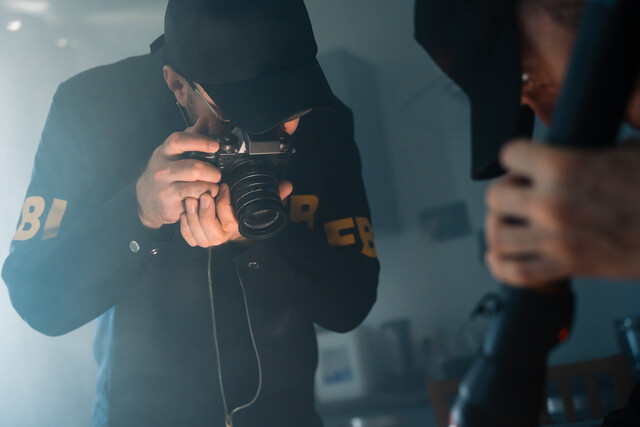Fingerprints can be visible to the naked eye. If they are not readily visible, they are known as latent fingerprints. Oils or perspiration in the skin causes these types of fingerprints, which leave impressions on objects like glass or shiny surfaces that are best seen with the use of flashlights or other lighting sources.
A plastic or molded fingerprint is also visible and defined as a material that can be molded or modeled. It is a print left on a soft surface that retains detail and may have a three-dimensional appearance. These types of prints are found commonly in dust and adhesive tape.
Knowing that, is a bloody fingerprint the same as a fingerprint in blood?
The answer is no. A fingerprint in blood is classified as a plastic, or molded print which has been left on the surface of a drop or pool of blood, for example. The bloody fingerprint, on the other hand, is an example of a person, having the foreign substance, in this case, blood, coating the finger or palm and leaving the fingerprint or mark on another surface.
- The subject, or suspect, could not have made the print
- The subject, or suspect, made the print
- The print could not be identified due to poor detail
Fingerprints, as well as footprints (the bare sole of a foot) and palm prints are made the same way as described above and are preserved in the same way.
In some cases, if the crime scene investigator is not sure if the print belongs to a finger, the side of a finger, a portion of the palm or the sole of a foot, it should be classified as a fingerprint.
Since fingerprints, palm prints and the bare footprints are made the same way, i.e., they are formed by friction ridges that leave grease and perspiration or other materials behind, they can occur whenever a person grasps an object or supports themselves in some way on a wall, a banister or a countertop as well as on the surface of guns, knives and other weapons.
Fingerprints can be found just about anywhere, but the point of entry and exit should be the first locations that are examined by crime scene investigators or other law enforcement personnel collecting evidence.
Trace Evidence:
Trace evidence is small or microscopic materials that may be overlooked at a crime scene unless the crime scene investigator takes great care in performing a search. There are hundreds of types of trace evidence, including the more common and familiar hairs, clothing and material-type fibers, or even plant spores and bits of dirt and minerals brought in or out of a core crime scene by the perpetrator.
Recall that this type of transfer is called Locard's Exchange Principal that designates that it is not possible to come into contact with any person or environment without in some way brining something with you or taking it away.
Clothing - Trace evidence clings to just about all types of fabrics that make up various articles of clothing. Both micro- and macroscopic substances burrow into the weave of materials by static electricity and become caught. However, they may also be shaken loose quite easily at times, which is why it's so important to collect evidence from clothing as soon as possible.
When a suspect is taken into custody, his or her clothing is usually inspected immediately for signs of physical evidence, and if found, is carefully documented. When checking clothing for trace evidence, care must be taken not to shake or otherwise jar fabric that might loosen bits and particles that may tie a perpetrator to the scene of the crime or a victim.
Clothing worn by a victim needs to be given careful consideration. Before the victim is undressed at the medical examiners office or other location, trace evidence that might remain on the clothing needs to be addressed before any other actions are taken. Either a crime scene investigator or Criminalist or pathologist should be involved in this process. Then, each piece of clothing must be removed and placed in a separate, clean paper wrapper. If clothing is still wet with blood or other body fluids, the clothing will need to air dry prior to sealing in evidence bags.
Footprints on Floors � Footprints and footprint impressions are often found at crime scenes. Glass, desktops, tile floors and even chair seats often reveal shoe or footprints. The best way to search for these without the use of special equipment is to turn off indoor lights and scan such surfaces with a high-intensity flashlight beam skimmed over surfaces at an angle. In most cases, such prints on an inside crime scene will be dust prints that can easily be destroyed, so care must be taken when moving about the location.
Trace Metals � Tests to determine the presence of trace metals at a crime scene is not an exact science � yet. Such test results are not always consistent, and because of the society we live in today, many people carry around microscopic bits of trace metals on a daily basis, leaving it difficult to unequivocally claim that a particular person left a specific trace metal at a crime scene location.
In the case of a trace metal detection test (TMDT), a suspect is often asked to hold out their hands, upon which a special solution is sprayed, in order to detect if the suspect recently held a gun in his or her hand. In many cases, a darkened area of skin will indicate the location of a metal object. In addition, in many cases, the amount of perspiration on a person's hands may affect the test result. In addition, a suspect who has washed his or her hands, placed them in their pockets or even rubbed them together can affect the results of such a test.
If a crime scene investigator or detective's intent is to determine whether or not a suspect has recently fired a weapon, a GSR test, or gunshot residue test, may produce more consistent results.
When a weapon is fired, microscopic elements and particles are naturally discharged on the hand of the person firing the weapon. These particles are especially sensitive to jarring movements, washing or even handcuffing. In such cases, these materials may be dislodged. However, if care has been taken, or the person who fired the weapon has no reason to believe he or she is under suspicion, the particles may remain for about six hours.
Weapons and Firearms � When it comes to firearms, determining the type of weapon used in the commission of the crime is a valuable tool to finding and apprehending a suspect. Determining the distance range by examining the victim's skin and clothing can determine how far away the killer was when the shot was fired, as well as to pinpoint the location of the killer in the room or area that constitutes the initial crime scene.
Hundreds of types of firearms are manufactured around the United States, and the world, but all of them can be classified into two groups: shoulder fired weapons, such as rifles or shotguns, and handguns, which include revolvers, pistols or automatic or semi-automatic weapons.
Not only is the type of weapon used of great importance in solving a crime, but the type of ammunition as well. Combined, ballistics experts can match bullets to the weapon that fired them with amazing accuracy.
Small arms ammunition can be classified into two types as well: center fire or rim fire. Rim fire cartridges are used mainly in .22 caliber weapons, while most other larger caliber cartridges are used in larger weapons.
Bullets, or even fragments of bullets recovered from a victim can be used in some cases to determine what type of weapon fired the projectile. In addition, trace and physical evidence found inside the barrel or the firing mechanism of a weapon may reveal 'blowback' or even bits of skin, hair or blood that may be analyzed to tie the weapon to either a victim or a suspect.
Any type of evidence found in a crime scene may enjoy only a brief existence. Therefore, it is imperative that the crime scene be process as soon after the discovery of a crime as possible. Contaminants, weather or a suspect may do their best to eradicate bits of trace evidence if allowed the time to do so.























